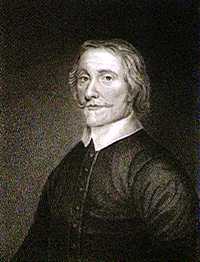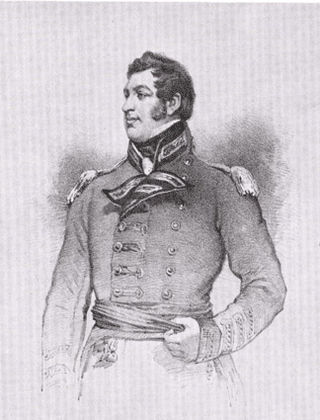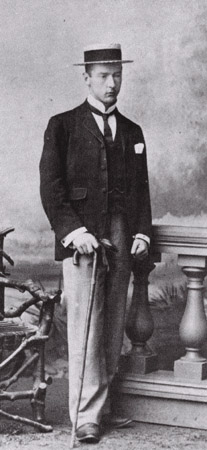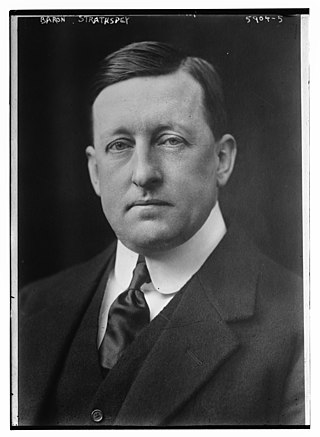
Baron Strathspey, of Strathspey in the Counties of Inverness and Moray, is a title that has been created twice, both times in the Peerage of the United Kingdom. On both occasions, the barony was created for an Earl of Seafield.

Baron Strathspey, of Strathspey in the Counties of Inverness and Moray, is a title that has been created twice, both times in the Peerage of the United Kingdom. On both occasions, the barony was created for an Earl of Seafield.
It was created for the first time on 14 August 1858 [1] for John Ogilvy-Grant, 7th Earl of Seafield (see the Earl of Seafield for earlier history of this title). This creation became extinct on the death of his son, the eighth Earl and second Baron, in 1884.
The barony was revived only a few months after it first became extinct [2] in favour of the late Earl's uncle, James Ogilvy-Grant, 9th Earl of Seafield (who had also succeeded him in the baronetcy of Colquhoun; see Colquhoun baronets for earlier history of this title). The barony and baronetcy remained subsidiary titles of the earldom until the death of the ninth Earl's grandson, the eleventh Earl, in 1915. The earldom, which could be passed on to female heirs, was inherited by the Earl's daughter and only child, the twelfth Countess (see the Earl of Seafield for later history of the earldom).
The baronetcy and barony of Strathspey, which could only be inherited by males, were passed on to the Earl's brother, the fourth Baron. His son, the fifth Baron, was confirmed in the surname of Grant of Grant by decree of the Lord Lyon in 1950. As of 2023 [update] the titles are held by the latter's younger son, the seventh Baron, who succeeded in 2023. His is the 34th Chief of Clan Grant.
There is no heir to the barony. [4]

Viscount Cobham is a title in the Peerage of Great Britain that was created in 1718. Owing to its special remainder, the title has passed through several families. Since 1889, it has been held by members of the Lyttelton family.

Earl of Kintore is a title in the Peerage of Scotland. It was created in 1677 for Sir John Keith, third son of William Keith, 6th Hereditary Earl Marischal of Scotland and Chief of Clan Keith. He was made Lord Keith of Inverurie and Keith Hall at the same time, also in the Peerage of Scotland. At the death of William, the 4th Earl, in 1761, the Earldom and Lordship became dormant, as no-one could prove a claim to them. In 1778, it was decided that the Earldom, Lordship and Chieftaincy of Clan should pass to Anthony Adrian Falconer, Lord Falconer of Halkerton, who changed his surname to Keith-Falconer. The Lordship Falconer of Halkerton and the Earldom of Kintore and Lordship Keith of Inverurie and Keith Hall remained united until 1966, when, at the death of the 10th Earl, the Lordship Falconer of Halkerton became dormant.

Earl of Seafield is a title in the Peerage of Scotland. It was created in 1701 for James Ogilvy, who in 1711 succeeded his father as 4th Earl of Findlater. The earldoms of Findlater and Seafield continued to be united until 1811, when the earldom of Findlater became dormant, while the earldom of Seafield remains extant.

Earl Ferrers is a title in the Peerage of Great Britain. It was created in 1711 for Robert Shirley, 14th Baron Ferrers of Chartley. The Shirley family descends from George Shirley of Astwell Castle, Northamptonshire. In 1611 he was created a Baronet, of Staunton Harold in the County of Leicester, in the Baronetage of England. He was succeeded by his son Henry, the second Baronet, who married Lady Dorothy Devereux, daughter of Robert Devereux, 2nd Earl of Essex. On the death of her brother Robert Devereux, 3rd Earl of Essex, she became the youngest co-heir to the baronies of Ferrers of Chartley and the barony of Bourchier, which had fallen into abeyance on the death of the third Earl. Shirley was succeeded by his eldest son, the third Baronet. He died unmarried and was succeeded by his younger brother, the fourth Baronet. He was imprisoned in the Tower of London by Cromwell and died there in 1656. On his death the title passed to his eldest son, the fifth Baronet. He died at an early age and was succeeded at birth by his posthumous son, the sixth Baronet.

Earl of Rosslyn is a title in the Peerage of the United Kingdom. It was created in 1801 for Alexander Wedderburn, 1st Baron Loughborough, Lord Chancellor from 1793 to 1801, with special remainder to his nephew Sir James St Clair-Erskine, as Wedderburn had no surviving issue of his own. Wedderburn had already been created Baron Loughborough, of Loughborough in the County of Leicester, in the Peerage of Great Britain in 1780, with normal remainder to the heirs male of his body, and Baron Loughborough, of Loughborough in the County of Surrey, in the Peerage of Great Britain in 1795, with the same remainder as the earldom. The 1780 barony became extinct upon his death, but the 1795 barony and the earldom passed, by the special remainder, to his nephew, who thus became the second Earl of Rosslyn. The second Earl was a Lieutenant-General in the Army and also held political office as Lord Privy Seal and Lord President of the Council.

Earl of Chichester is a title that has been created three times, twice in the Peerage of England and once in the Peerage of the United Kingdom. The current title was created in the Peerage of the United Kingdom in 1801 for Thomas Pelham, 2nd Baron Pelham of Stanmer.

Earl of Limerick is a title that has been created twice in the Peerage of Ireland, associated first with the Dongan family, then with the Pery family. It should not be confused with the title Viscount of the City of Limerick held by the Hamilton family also Earls of Clanbrassil.

Earl of Cottenham, of Cottenham in the County of Cambridge, is a title in the Peerage of the United Kingdom. It was created in 1850 for the prominent lawyer and Whig politician Charles Pepys, 1st Baron Cottenham. ) He served as Lord Chancellor from 1836 to 1841 and from 1846 to 1850. Pepys had already been created Baron Cottenham, of Cottenham in the County of Cambridge, in 1836, and was made Viscount Crowhurst, of Crowhurst in the County of Surrey, at the same time he was given the earldom. These titles are also in the Peerage of the United Kingdom. The viscountcy is used as a courtesy title for the Earl's eldest son and heir apparent.

Viscount Valentia is a title in the Peerage of Ireland. It has been created twice. The first creation came in 1621 for Henry Power. A year later, his kinsman Sir Francis Annesley, 1st Baronet, was given a "reversionary grant" of the viscountcy, which stated that on Power's death Annesley would be created Viscount Valentia. Annesley, a member of an influential Anglo-Irish family which descended from Newport Pagnell in the County of Buckinghamshire, was a favourite of James I, who granted him land in Ireland, notably the fort of Mountnorris in County Armagh. He was knighted in 1616, created a baronet, of Newport Pagnell in the County of Buckingham, in the Baronetage of Ireland in 1620 and Baron Mountnorris, of Mountnorris in the County of Armagh, in 1628.

Baron Dufferin and Claneboye, of Ballyleidy and Killyleagh in County Down, Northern Ireland, is a title in the Peerage of Ireland. It was created on 30 July 1800 for Dame Dorcas Blackwood, widow of Sir John Blackwood, 2nd Baronet, Member of the Irish Parliament for Killyleagh and Bangor, in return for support for the Union of Ireland and the United Kingdom.

Colonel Francis William Ogilvy-Grant, 6th Earl of Seafield was a British Conservative Member of Parliament, military officer, and the 25th Chief of Clan Grant. He was appointed Scottish representative peer between 1841 and 1853.

John Charles Ogilvy-Grant, 7th Earl of Seafield,, styled Viscount Reidhaven from 1840 to 1853, was a Scottish nobleman. He is numbered as the 26th Chief of Clan Grant.

Clan Colquhoun is a Highland Scottish clan.
There have been two baronetcies created for persons with the surname Colquhoun ("Cohoon"), one in the Baronetage of Nova Scotia (1625) and one in the Baronetage of Great Britain (1786).

Captain James Ogilvy-Grant, 11th Earl of Seafield, 3rd Baron Strathspey JP DL was a New Zealand soldier who succeeded to the Earldom of Seafield in the Peerage of Scotland.
Lieutenant Colonel James Ogilvy-Grant, 9th Earl of Seafield, known for most of his life as the Hon. James Ogilvy-Grant, was a Scottish peer and Conservative Member of Parliament (MP).

Francis William Ogilvy-Grant, 10th Earl of Seafield,2nd Baron Strathspey, styled as Viscount Reidhaven from 1884 to 1888 and known as simply FrancisGrant for most of his life, was an Irish-born emigrant to New Zealand who became a peer for several months in 1888.

Trevor Ogilvy-Grant, 4th Baron Strathspey was a New Zealand-born Scottish peer, who upon becoming Lord Strathspey in 1915 emigrated to Britain and took his seat in the House of Lords.

Nina Caroline Ogilvy-Grant, 12th Countess of Seafield was a Scottish peeress.

Earl of Arran is a title in the Peerage of Ireland. It is not to be confused with the title Earl of Arran in the Peerage of Scotland. The two titles refer to different places: the Aran Islands in Ireland, and the Isle of Arran in Scotland. The Irish earldom is held by the Gore family. The Scottish earldom is a separate title, held as a subsidiary title of the Duke of Hamilton.